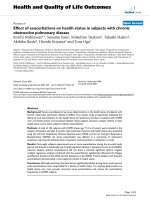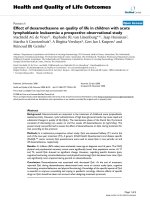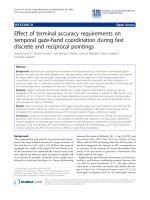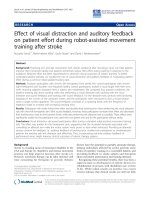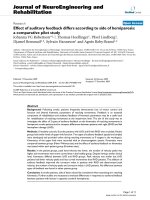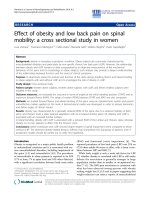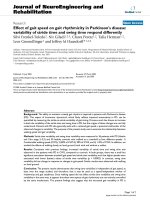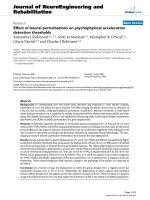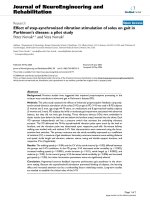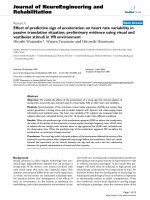Báo cáo hóa học: " Effect of thermal treatment on the growth, structure and luminescence of nitride-passivated silicon nanoclusters" pptx
Bạn đang xem bản rút gọn của tài liệu. Xem và tải ngay bản đầy đủ của tài liệu tại đây (1.06 MB, 12 trang )
NANO EXPRESS Open Access
Effect of thermal treatment on the growth,
structure and luminescence of nitride-passivated
silicon nanoclusters
Patrick RJ Wilson
1*
, Tyler Roschuk
1
, Kayne Dunn
1
, Elise N Normand
2
, Evgueni Chelomentsev
1
,
Othman HY Zalloum
1
, Jacek Wojcik
1
, Peter Mascher
1*
Abstract
Silicon nanoclusters (Si-ncs) embedded in silicon nitride films have been studied to determine the effects that
deposition and processing parameters have on their growth, luminescent properties, and electronic structure.
Luminescence was observed from Si-ncs formed in silicon-rich silicon nitride films with a broad range of
compositions and grown using three different types of chemical vapour deposition systems. Photoluminescence
(PL) experiments revealed broad, tunable emissions with peaks ranging from the near-infrared across the full visible
spectrum. The emission energy was highly dependen t on the film composition and changed only slightly with
annealing temperature and time, which primarily affected the emission intensity. The PL spectra from films
annealed for duration of times ranging from 2 s to 2 h at 600 and 800°C indicated a fast initial formation and
growth of nanoclusters in the first few seconds of annealing followed by a slow, but steady growth as annealing
time was further increased. X-ray absorption near edge structure at the Si K- and L
3,2
-edges exhibited composition-
dependent phase separation and structural re-ordering of the Si-ncs and silicon nitride host matrix under different
post-deposition annealing conditions and generally supported the trends observed in the PL spectra.
Introduction
Quantum confinement effects have been found to
improve the efficiency of radiative recombination in sili-
con [1]. In accordance with Heisenberg’s uncertainty
principle, the spatial confinement of the charge carriers
induces a spread in their momenta, allowing for quasi-
direct radiative transitions to occur in an indirect band-
gap semiconductor. Utilizing these quantum confine-
ment effects, efficient light emission has been achieved
from silicon nanoclusters (Si-ncs) formed in a dielectric
host matrix. While the properties of this luminescence
have been observed to depend on the size of the Si-ncs,
difficulties arise in the understanding of these materials
from the effects related to the Si-nc/dielectric interface,
as well as from the specific physical properties of the
dielectric matrix. This situation is further compounded
by fabrication-specific issues, where the use of different
deposi tion systems or source gases for the fabrication of
Si-nc-containing thin films can alter the observed opti-
cal behaviour of the materials, requiring continued
resear ch to gain a bette r understanding of this materials
system [2,3].
Forming Si-ncs in a silicon nitride host matrix offers
several key advantages over silicon oxide, which was the
focus of many early studies [4-9]. Silicon nitride is a
promising host matrix candidate since it is a structurally
stable dielectric commonly used in microelectronic fab-
rication processes. Favourable electrical properties
resulting from the lower tunnelling barriers allow for
better transport of electronsandholesintoSi-ncs
formed in silicon nitride, making these films better sui-
ted for electroluminescent device applications [10]. In
addition, Si-ncs coordinated with oxygen atoms are sub-
ject to charge trapping related to double-bonds between
silicon and oxygen at the interface, which effectively
limits the emission from such Si-ncs to energies less
than approximately 2 eV, regardless of Si-nc dimensions
[11]. Since Si-ncs coordinated with nitrogen atoms do
* Correspondence: ;
1
Department of Engineering Physics and Centre for Emerging Device
Technologies, McMaster University, 1280 Main Street West, Hamilton, Ontario
L8S4L7, Canada
Full list of author information is available at the end of the article
Wilson et al. Nanoscale Research Letters 2011, 6:168
/>© 2011 Wilson et al; licens ee Springer. This is an Open Access article distributed under the terms of the Creative Commons Attribution
License ( which permits unrestricted use, distribution, and reproduction in any medium,
provided the original work is properly cited.
not exhibit the same limitation, emission has been
demonstrated to occur at energies across the entire visi-
ble spectrum [10,12,13]. The process of forming Si-ncs
in silicon nitride is also more favourable due to much
lower annealing temperature requirements for bright
luminescence compared to silicon oxide films where
temperatures must typically exceed 1000°C [14]. In fact,
even before annealing, silicon-rich silicon nitride (SRSN)
films grown by plasma-enhanced chemical vapour
deposition (PECVD) can exhibit efficient luminescence.
However, the formation of Si-ncs in SRSN films has
been found to occur in a more complex fashion, with
formation of both amorphous and crystalline clusters
being reported and a strong dependence on both
deposition and processing conditions [10,15-17].
In this article, Si-ncs formed in SRSN films deposited
with varied compositions using three different chemical
vapour deposition (CVD)-based systems are compared
and discussed: plasma-enhanced CVD (PECVD), induc-
tively coupled plasma CVD (ICP CVD), and electron
cyclotron resonance PECVD (ECR PECVD). Results
from these studies have been previously reported in two
conference proceedings [18,19]. Most studies to date
have employed isochronal annealing steps after deposi-
tion to induce diffusion of excess silicon to nucleation
sites. Conventionally, this has been done using a quartz
tube furnace with an ambient gas of N
2
or N
2
+5%H
2
(i.e. forming gas) over 60 min. For consistency, this
approach has been taken to provide a good comparison
amongst the three deposition systems studied. However,
whilst this provides for good comparison amongst the
results of various studies, to date there has not bee n an
in- depth isothermal study wherein the annealing is per-
formed over a large time scale ranging from seconds to
hours. To address this gap in reported da ta, in this
study, SRSN thin films have been annealed for times
ranging from 2 s to 2 h using rapid thermal annealing
to provide a basis for investigating the growth process
and thermal evolution of thesefilmsaswellasdeter-
mining the flexibility of the processing conditions over
which such a film could be incorporated into a larger
device design.
Experimental details
In comparing the three CVD systems, SRSN thin films
were deposited on n-type (100) Si substrates. The sam-
ple compositions w ere controlled through the variation
of the deposition gas flow rates, adjusting the nitrogen
source rate while keeping the s ilicon source rate con-
stant. Unless otherwise stated, all depositions were per-
formed with a substrate heater temperature of 300°C,
and the system-specific data for the silicon and nitrogen
source gases, radio frequency (RF) power for PECVD
and ICP CVD, or microwave (MW) power for ECR
PECVD, film thicknes s, and deposition rate are all listed
in Table 1. Post-deposition, the samples were subjected
to thermal annealing in a quartz tube furnace for 60
min under either flowing N
2
or N
2
+5%H
2
. T he char-
acteristics of the Si-ncs are strongly dependent on both
deposition and processing parameters, as evidenced by
variations in their measured luminescent properties and
electronic structure . The films s tudied in the isothermal
annealing experiments were deposited by the ECR
PECVD system using similar parameters as employed in
the system comparison, except that the films in this case
were grown to be appro ximately 3000 Å thick and were
deposited using a substrate heater tempera ture of 350°C
(unless otherwise stated). The higher temperature was
used since this was generally found to produce SRSN
films with increased photoluminescence (PL) intensity
for this particular system. For better temporal accu racy,
the post-deposition annealing was performed using a
Qualiflow Jipelec Jetfirst 100 rapid thermal processor
(RTP) rather than a quartz tube furnace. The isothermal
study was performed using temperatures of 600 and
800°C with a ramp rate of 25°C/s unde r flowing N
2
gas
for times ranging from 2 to 7200 s. The emission spec-
tra of the films were measured via room temperature
ultraviolet-excited PL using a 17 mW HeCd laser emit-
ting at 325 nm. The complete details of our PL set up
have been described elsewhere [20]. Film compositions
were measured using Rutherford backscattering spectro-
metry (RBS) conducted in the Tandetron Accelerator
Laboratory at the University of Western Ontario. Finally,
X-ray absorption near edge structure (XANES) experi-
ments were performed to obtain information on the
electronic structure of the films at the Si K- and L
3,2
-
edges. The XANES measurements were conducted on
the high resolution spherical grating monochromator
(SGM) [ 21] and variable line spacing plane grating
monochromator (VLS PGM) [22] beamlines at the
Canadian Light Source synchrotron facility. In these
experiments, both the total electron yield (TEY) and
total fluorescence yield (FLY) were measured
Table 1 System specific details for SRSN thin film depositions
CVD system Si source gas N source gas RF/MW power (W) Film thickness (Å) Deposition rate (Å/min)
PECVD 5% SiH
4
/Ar NH
3
50 2200-2600 110-130
ICP CVD 30% SiH
4
/Ar N
2
300 2400-3000 26-30
ECR PECVD 30% SiH
4
/Ar 10% N
2
/Ar 500 800-1200 53-60
Wilson et al. Nanoscale Research Letters 2011, 6:168
/>Page 2 of 12
simultaneously, normalized to the incident X-ray inten-
sity (I
0
). These yields provide information over different
depths within the sample because of the relative mean
free paths of secondary electrons and fluorescence
photons at the absorption edges probed. Information on
the bulk of the film was provided by the TEY spectra at
the Si K-edge and the FLY spectra at the Si L
3,2
-edge.
Results and discussion
Sample composition
The films produced by each of the three deposi tion sys-
tems for the isochronal annealing experiments covered a
broad range of compositions from stoichiometric Si
3
N
4
to 14 at.% excess silicon content (Si
ex
) relative to stoi-
chiometry. Here, the excess silicon content for substoi-
chiometric silicon nit ride films with composition SiN
x
has been defined as:
Si
ex
=Si
at.%
/(Si
at.%
+N
at.%
) - 3/7 = (1 + x)
-1
- 3/7.
Film compositions were determined by fitting experi-
mental RBS data from the as-depo sited (AD) film s with
simulated spectra using the SIMNRA software package
[23] and all quoted percentagesinthisstudyreferto
atomic percentages derived from these measurements.
Owing to the inherently poor sensitivity of RBS in mea-
suring lower atomic number elements such as nitrogen,
the values obtained from the fits have been rounded to
the nearest percent, and values measured below 0.5%
have been labelled as <1% to account for the uncertainty
in the data. The films used in the isothermal annealing
experiments were measured to be moderately silicon-
rich, having e xcess silicon contents of 2-3%. Of these
films, the one used to study the Si K-edge XANES was
deposited at a slightly lower substrate temperature of
300°C, which could have a minor effect on the film’ s
properties. H owever, for the purposes of this study, the
compositions of these films were similar enough to
draw qualitative comparisons between the trends
observed in the PL and XANES spectra obtained from
the different samples.
Isochronal comparison of deposition systems
The luminescent properties of the various films were
analysed through their room temperature ultraviolet-
excited PL spectra. Figure 1 compares the PL spectra
from the AD samples from the three systems. Note that
the ECR PECVD film with 2% excess silicon content
depicted in this figure was grown using a slightly higher
substrate heater temperature of 350°C, which may have
resulted in higher emission intensity than a film with
similar composition deposited at 300°C. Despite the dif-
ferences in deposition conditions between the systems,
similar trends can be observed. Each system produces
AD films exhibiting bright PL with emission energies
that can be controlle d through the full range of the visi-
ble and into the near-infrared portion of the electromag-
netic spectrum by increasing the excess silicon content
in the film. This correlates well with expected quantum
confinement effects as Si-ncs increase in size. However,
for each system, the emission occurs across a broad
range of energies and appearstooriginatefromacom-
bination of quantum confinement effects and defect
levels, which have peaks at approximately constant ener-
gies independent of the film compositio n. These defect-
related peaks are most prominent in films with low
excess silicon content, in which smaller Si-ncs form. As
the dimensions of the Si-ncs are reduced, the defect
levels become excited and emission through these levels
becomes more dominant. The fact that significant PL
intensity is observed in the AD films indicates that Si-
ncs are formed within SRSN films without the assistance
of annealing. This is different from what occurs in sili-
con-rich silicon oxide (SRSO) films where cluster forma-
tion and resulting luminescence occur only af ter high
temperature annealing [14]. The PL intensity of the
SRSN films in this study has been qualitatively described
as ‘ bright’, which is a rather arbitrary term. Since quan-
titative measurements of emission intensity have yet to
be performed, the term bright is qualified here as PL
Figure 1 PL spectra for as-deposited SRSN films grown by (a)
PECVD, (b) ECR PECVD, and (c) ICP CVD with their respective
excess silicon contents specified in the legend. As excess silicon
content increases, emission shifts to lower energies.
Wilson et al. Nanoscale Research Letters 2011, 6:168
/>Page 3 of 12
that is easily visible under typical room lighting
conditions.
The effects of annealing a PECVD film with moder-
ately high excess silicon content and an ICP CVD film
with low excess silicon content using different ambient
gases are compared in Figure 2. In general, the emission
spectra for samples with higher excess silicon content
tend to red-shift slightly as the annealing temperature is
increased, whereas lower excess silicon content samples
exhibit a slight blue-shift. In samples containing inte r-
mediate levels of excess silicon content, the PL peaks
have also been observed to blue -shift relative to the AD
spectra at low temperatures and red-shift as t he anneal-
ing temperature is further increased. There appear to be
at least two competing mechanisms in the Si-nc growth
dynamics related to the growth of existing Si-ncs due to
diffusion of silicon ato ms in the film and the formation
and subsequent growth of new Si-ncs at nucleation
sites. The red-shifting resulting from Si-nc growth is
much smaller than that observed in SRSO films, but this
can be explained by the more diffusion- inhibiting struc-
ture of the silicon nitride matrix relati ve to the silicon
oxide matrix [24]. It is also possible that energy may be
transferred between smaller and larger Si-ncs, which
affects the observed PL spectra. In all of the samples,
the most intense emission consistently occurred when
annealing was performed at 800°C or below, with peak
intensities being observed at lower temperatures for
higher silicon content samples. The reason for the decay
in PL intensity at higher temperatures is unknown at
this time since (a) Si-ncs are still present in TEM
images (not shown) and X-ray absorption spectra of
these films and (b) the Si-ncs have not grown beyond
the quantum confinement regim e because of the inhibi-
tive nature of the nitride matrix. As the decay in lumi-
nescence does not appear to relate to structural changes
in the Si-nc, this suggests that it results from changes in
the host nitride matrix or with the interface passivation.
Such effects could arise from the strain induced on the
Si-ncs by the nitride matrix or a re-ordering of the
nitride matrix structure at the Si-nc interface such that
non-radiative recombination pathways b ecome available.
However, further investigation is required to accurately
attribute the source of this phenomenon.
Figure 2 PL spectra for films annealed for 60 min in a quartz tube furnace. Shown are an ICP CVD film (Si
ex
< 1%) annealed in (a) N
2
, (b)
N
2
+5%H
2
and a PECVD film (Si
ex
= 3%) annealed in (c) N
2
, and (d) N
2
+5%H
2
.
Wilson et al. Nanoscale Research Letters 2011, 6:168
/>Page 4 of 12
Hydrogen passivation of dangling bonds at the Si-nc
interfaceisalsoobservedtoplayasignificantrolein
improving the PL efficiency. The use of N
2
+5%H
2
rather than pure N
2
as an ambient gas in the annealing
process significantly improves the emission intensity in
the ICP CVD- and ECR PECVD-deposited films. This
enhancement is not observed in the PECVD-deposited
films, which may be because this system uses NH
3
as a
nitrogen source. Higher concentrations of hydrogen may
remain in the film after dissociating from the NH
3
gas
molecules during the CVD reac tion process. Having
increased levels of hydrogen in the AD PECVD films
could be very beneficial when considering incorporating
these types of luminescent films into a larger scale design
process, such as for electroluminescent and integrated
circuit device processing, provided it does not reduce the
quality of the film through increased porosity or the
effects of out-gassing. Low temperature rapid thermal
annealin g is preferable in such cases due to the shorter
timescale and reduced thermal budget, providing b etter
compatibility with other materials, structures, or pro-
cesses. Lower temperatures with shorter anneals become
particularly important for avoiding the diffusion of metals
from contacts, and potentially reducing the number of
design steps required compared to the typically longer
quartz tube furnace annealing. The effects of the anneal-
ing time on the growth, structure and luminescence of
SRSN films are addressed in ‘Isothermal anneals at 600°
C’ and ‘Isothermal anneals at 800°C’ below.
The electronic structure was probed through X-ray
absorption near edge structure experiments at the sili-
con K- and L
3,2
-edges, where differences in structure
within the films can be identified by shifts in their spec-
tral features [25-29]. The XANES measurements per-
formed at the silicon K-edge for AD films from each
system are shown in Figure 3, which reveal common
trends in the Si-nc structure. The spectra of the ICP
CVD films were measured from 2-μ m-thick films, much
larger than the information depth at either absorption
edge [30], to ensure that the substrate would not contri -
bute to the TEY or FLY. However, through further
experiments, it has s ince been found that film thick-
nesses greater than 1500 Å are su fficient not to exhibit
substrate effects in the TEY data at the Si K-edge, or
either the TEY or FLY data at the Si L
3,2
-edge. A l ow
doped, n-type (100) silicon wafer was used as a crystal-
line silicon reference f or all of the XANES experiments,
and the Si
3
N
4
referencesamplewasanADICPCVD
film with stoichiometric composition. As the silicon
content is increased in the film s, the absorption edge
shifts to lower energies because of the increase of the
Si-Si resonance peak at 1842 eV and reduction of the
peak related to Si-N bonding located at 1845.5 eV. The
weak Si-O peak at 1848 eV in the crystalline silicon
reference spectrum arises from the native oxide layer
formed at the silicon surface while any Si-O signal
exhibited by the SRSN films originates from oxygen
contaminati on at the surface of the film and shoul d not
be taken as an indication of Si-O bonding within the
bulk of these films. Figure 4 compares the silicon L
3,2
-
edge spectra for PECVD and ICP CVD AD films. Both
sets of films follow similar trends, with the Si-N reso-
nance peak ranging between 103.8 to 104.5 eV as it
shifts to lower energies and broadens at higher excess
silicon concentrations. However, the PECVD films have
a well-defined Si-Si absorption edge at 99.7 eV, which is
absent in the ICP CVD-deposited films. The prominence
of the absorption edge in PECVD films could be attribu-
ted to a difference in the Si-nc st ructure or the genera-
tion of a greater number of nuclea tion sites for Si-nc
formation resulting from the dissociation of hydrogen
from the NH
3
process gas. Unfortunately, the ECR
PECVD films were too thin to avoid a large background
signal from the silicon substrate at these energies, and
so they have not been included in any of the Si L
3,2
-
edge comparisons.
Figures 5 and 6 show the changes in the Si K- and
L
3,2
-edge XANES spectra for two ICP CVD grown films,
Figure 3 TEY-XANES spectra for (a) PECVD, (b) ECR PECVD, and
(c) ICP CVD AD films at the Si K-edge. A, B, and C indicate the
peak positions for Si-Si, Si-N, and Si-O resonances, respectively. The
percentages in the legend refer to the excess silicon content of the
SRSN films.
Wilson et al. Nanoscale Research Letters 2011, 6:168
/>Page 5 of 12
one with low excess silicon content (Si
ex
<1%)andthe
other with high excess silicon content (Si
ex
= 5%), as the
annealing temperature is increased. At temperatures of
900°C and above, films with low excess silicon concen-
tration develop a shoulder at the Si-Si bonding energy
of 1842 eV, suggesting a change in the Si-nc structure
and increased phase separation in these films. The posi-
tion of the Si-N resonance peak shifts to higher ener-
gies, from 1845.5 to 1846 eV, and increases in
magnitude as the annealing temperature is increased. At
the silicon L
3,2
-edge, the Si-Si absorption edge at 99.7
eV is suppressed, and details of the Si clustering are not
observed while the nitride matrix undergoes a clear
change in structure up to 1100°C when the nitride
matrix appears to break down. In films with high excess
silicon content, the onset of the Si-Si shoulder in the
silicon K-edge spectra occurs at temperatures as low as
600°C. This indicates that the phase separation and Si-
nc formation are not solely dependent on the nitride
host matrix and are instead strongly influenced by the
composition of the deposited film. Changes to the Si-N
peaks in the silicon K- and L
3,2
-edge spectra once again
reflect structural changes in the nitride matrix. At the
silicon L
3,2
-edge, the d etails of Si-Si bonding are also
suppressed in these films until 1100°C where the nitride
matrix breaks down.
Analysis at the sil icon L
3,2
-edge is hindered by sub-
stantial distortion of the FLY signal due to eit her self-
absorption effects, which intensify as the film density
increases with higher annealing temperatures, or aug-
mentation of X-ray scattering resulting from voids
formed within the film [31]. Preliminary results from
positron annihilation spectroscopy experiments suggest
that void formation is at least partially responsible for
the distortion observed, but it remains to be established
as a full investigation of this effect is still underway. The
distortion is most prominent in high excess silicon con-
tent films deposited by the PECVD system, although it
is observed to some degree in all of the SRSN films
measured at the Si L
3,2
-edge. An example of this effect
is shown in Figure 7. As the annealing temperature is
increased, a dip grows in the FLY at energies between
the Si-Si absorption edge and the higher energy side of
the Si-N resonance peak. A full account of this effect is
Figure 4 FLY-XANES spectra for as-deposited (a) PECVD and (b) ICP CVD films at the Si L
3,2
-edge. The spectra are offset by a constant
value in the order they are listed in the legend, in which the excess silicon content of the SRSN films is specified as a percentage. The Si-N
resonance peak shifts to lower energies in films with higher excess silicon content.
Wilson et al. Nanoscale Research Letters 2011, 6:168
/>Page 6 of 12
a non-trivial challenge yet to be corrected for this data,
which, however, is certainly necessary to gain accurate
and specific information on the changes in the silicon
nitride host matrix.
Isothermal anneals at 600°C
As described previously, in the case o f isochronal
annealing for 60 min in a quartz tube furnace, the PL of
SRSN films with moderate-to-high excess silicon con-
tent tends to shift towards lower energies as the anneal-
ing temperature increases. Such a shift is in agreement
with theory for quantum confinemen t effects corre-
sponding to the growth of Si-ncs where the bandgap
energy is proportional to the inverse square of the
nanocluster diameter. Figure 8 shows the PL spectra for
a film with 3% excess Si content annealed at 600°C for
time intervals ranging from a mere 2 s to 2 h. In this
figure, the annealed PL spectra were renormalized to
have the same peak height to aid in comparing changes
in emis sion energies while the AD spectra was renorma-
lized to maintain its relativ e intensity compared to the 2
s anneal. Each spectrum consisted of a m ain peak that
shifted to lower energies as the annealing time
increased, and a higher e nergy shoulder tha t was most
prominent in the AD film, which diminished as the
annealing time increased. There was an abrupt red-shift
in peak emission energy from 2.58 eV in the AD film to
2.13 eV after only 2 s of annealing along with a large
increase in intensity. As the annealing time was
increased further, the PL peak continued to shift
towards lower energies, but these changes were rela-
tively small compared t o the initial shift. This indicates
that Si-ncs form and begin to grow very rapidly through
a transient diffusion of excess silicon.
The peak emission energies of the annealed spectra
areshownonasemilogplotinFigure9a.ThepeakPL
energy was determined by applying a Savitzky-Golay
smoothing filter to remove the effects of noise without
distorting the shape of the spectra and locating the
energy at which the peak PL intensity occurred. There
is a clear and steady shift from approximately 2.15 eV
for the very short anneals towards 2.00 eV for annealing
times approaching 2 h in length. The trend is character-
ized in the diagram by a logarithmic fit o f the data
points. The high energy shoulder in the PL spectra can
be attributed to one of the silicon nitride inter -bandgap
defect levels [32], which was annealed out as th e length
of annealing time increased. Figure 9b shows a semilog
plot of the total power density of the annealed films as a
function of annealing time with a dashed line represent-
ing the total power density of the AD film. Annealing
caused a sharp increase in the PL intensity even at the
shortest annealing times. Following this sudden increase,
the total power density for the 600°C annea ls continued
to improve as t he annealing time increased up to 2 h,
albeit at a much slower rate.
XANES measurements provided insight on the struc-
tural ordering of the Si-ncs and the sili con nitride host
matrix. Several spectra measured at the Si K- and L
3,2
-
edges are shown in Figures 10 and 11, respectively. At
the Si K-edge, a gradual increase in Si-Si bonding was
observed in a 3% excess Si content film with increasing
annealing time corresponding to larger Si-ncs and
increased phase separation. Also, there was a large
increase in the Si-Si bonding resonance over the AD
spectrum even at very short a nnealing times. Large
restructuring o f the silicon nitride host matrix was also
observed on the same time scale as evidenced by the
significant changes in the Si-N bonding resonance over
the course of anneal ing. Similar changes were obtai ned
at the Si L
3,2
-edge for a film with 2% excess Si content,
where the Si-Si absorption edge becomes very large
Figure 5 TEY-XANES spectra at the Si K-edge for (a) low (Si
ex
<
1%) and (b) high (Si
ex
= 5%) excess silicon content films
deposited by the ICP CVD system and annealed in a quartz
tube furnace under N
2
+5%H
2
ambient gas. The insets
included with each plot show a magnified view of the Si-Si
absorption edge with the offset between spectra removed. A Si-Si
resonance shoulder onsets at temperatures as low as 900°C in the
low Si content film and 600°C in the high Si content film.
Wilson et al. Nanoscale Research Letters 2011, 6:168
/>Page 7 of 12
after the 60 s anneal and significant changes in both the
peak energy and the magnitude of the Si-N resonance
are observed over the timescale studied. Combined with
the large changes measured in the PL spectra for
annealing times on the order of seconds, these results
suggestthatSi-ncsformmuchmorerapidlythanhas
been conventionally believed and it is likely the result of
a fast transient diffusion mechanism for excess silicon in
a silicon nitride film.
Isothermal anneals at 800°C
The PL spectra for the film with 3% excess silicon con-
tent annealed at 800°C exhibited the same features as
those of the 600°C annealed films as can be seen in Fig-
ure12.AsinFigure8,theannealedspectrahavebeen
renormalized so that they have the same peak intensity
while the AD spectrum has been renormalized so that it
maintained its relative intensity with the 2 s anneal. In
this case, the AD peak appears smaller than in Figure 8
due to the relatively large PL intensity of the 2-s-
annealed film at 800°C compared with its 600°C coun-
terpart. At 800°C, there was still a main peak that red-
shifted with longer annealing times and a high energy
shoulder that was less pronounced than at the lower
temperature and nearly disappeared at the longer
annealing times. The peak PL energy is plotted in Figure
9a, which illustrates that the initial abrupt energy shift
upon annealing is much larger than for the 600°C
anneals and even exceeds the shift observed for all but
the longest anneals measured at this temperature. How-
ever, for longer anneals, the peak PL energy shifted at a
much slower rate than at 600°C. This was likel y due to
the reduction of excess silicon in the film within close
proximityofaSi-ncthathas not already b een incorpo-
rated into the stru cture and th e larger numb er of addi-
tional Si atoms required for continuing to increase the
diameter of a Si-nc as it grows. The total power density
profile shown in Figure 9b shows some interesting dif-
ferences to those observed after the 600°C anneal. At
800°C, there was a very large increase in the emission
Figure 6 FLY-XANES spectra at the Si L
3,2
-edge for (a) low (Si
ex
< 1%) and (b) high (Si
ex
= 5%) excess sili con content films dep osited
by the ICP CVD system and annealed in a quartz tube furnace under flowing N
2
+5%H
2
gas. The spectra are offset by a constant value
in the order they are listed in the legend, and the (100)Si spectra are normalized to the Si-Si absorption edge step in the 1100°C spectra for
better comparison.
Wilson et al. Nanoscale Research Letters 2011, 6:168
/>Page 8 of 12
Figure 7 FLY-XANES spectra at the Si L
3,2
-edge for a high
excess silicon content PECVD film (Si
ex
= 6%) annealed in a
quartz tube furnace under N
2
ambient gas. The offset spectra
are labelled underneath.
Figure 8 PL spectra for films with Si
ex
= 3% annealed at 600°C.
The annealed spectra are renormalized to have equal peak heights
and offset in order of increased annealing time to clearly show the
shifting in peak PL energy that occurred with annealing.
Figure 9 PL characteristi cs of films with Si
ex
=3%annealedat
600 and 800°C. The plots depict (a) the peak PL energy and (b)
the total power density of films annealed for times ranging from 2 s
to 2 h under flowing N
2
ambient gas. Logarithmic fit lines are
included in (a) to emphasize the trend of peak PL energy shifting
to lower energies with longer annealing times and are not intended
to represent a model.
Figure 10 TEY-XANES spectra at the Si K-edge for a film with
Si
ex
= 2% annealed for different times at 600°C.
Wilson et al. Nanoscale Research Letters 2011, 6:168
/>Page 9 of 12
intensity after just 2 s of annealing, which also far
exceeded the total power densities measured for any of
the 600°C anneals. While an overall increase in total
power density was observed at 600°C over the range of
annealing times studied, an intensity peak was observed
between 6 and 30 s at the higher temperature, followed
by a steady decline, eventually dropping below the 600°C
value at the 900 s mark. This decline may indicate
Ostwald ripening or s tructural changes in the silicon
nitride host matrix.
The occurrence of Ostwald ripening and silicon
nitride structural reordering are evidenced by the Si K-
edge XANES spectra for the 2% excess Si content film
shown in Figure 13. These spectra exhibit a large
increase in the Si-Si resonance after just 2 s of annealing
but no noticeable change as the annealing time is
extended, sug gestin g tha t further increases in Si-nc size
are due to larger nanoclusters growing at the expense of
smaller ones. At the same time, large changes were
observed in the Si-N resonance, which include a signifi-
cant increase between the 10 and 60 s anneals.
It is probable that the decay in PL intensity observed
for longer anneals at 800°C will occur after annealing
for a minimum time at higher temperatures as well. If
this assumption is true and the onset of decay occurs at
earlier times as the temperature is increased, then this
phenomenon may be linked to the decrease in PL inten-
sity observed in SRSN films annealed for 60 min in a
quartz tube furnace at tempera tures above 700 or 800°
C. Incidentally, as shown in Figure 9b, the 60 min mark
resides in the time interval where the 800°C annealed
films became less intense than the 600°C annealed films.
Conclusions
We have demonstrated that bright luminescence can be
attained from Si-ncs formed in SRSN thin films deposited
by PECVD, ICP CVD and ECR PECVD using different
combinations of source gases. Each system produced films
with hi ghly tunable lum inescence through adjustment of
the process gas flow rates. Post-deposition annealing only
had a minor impact on the peak PL energy, but the
annealing temperature and ambient gas strongly affe cted
the PL intensity. For 60 min anneals in a quartz tube fur-
nace, the best results were achieved at low temperatures
Figure 11 FLY-XANES spectra at the Si L
3,2
-edge for a film with
Si
ex
= 3% annealed for different times at 600°C.
Figure 12 PL spectra for Si
ex
= 3% films annealed at 800°C. The
annealed spectra are renormalized to have equal peak heights and
offset in order of increased annealing time.
Figure 13 TEY-XANESspectraattheSiK-edgefortheSi
ex
=
2% film annealed for different times at 800°C.
Wilson et al. Nanoscale Research Letters 2011, 6:168
/>Page 10 of 12
under flowing N
2
+5%H
2
gas. Hydrogen appeared to play
an important role in enhancing luminescence from SRSN
films. Much of this may be attributed to hydrogen passiva-
tion of dangli ng bonds at the Si-nc sur faces, but XANES
spectra at the Si K- and L
3,2
-edge also indicated that
hydrogen incorporated within the AD film may increase
the number of nucleation sites for Si-nc formation. In
addition, the XANES spectra provided evidence of compo-
sition-dependent phase separation and structural re-order-
ing of both the Si-ncs and the nitride host matrix upon
annealing. Unfortunately, self-abso rption or photon scat-
tering from void formation in the film obscures the Si-Si
and Si-N resonance peaks at the Si L
3,2
-edge, and a full
account of this effect has yet to be realized. This obstacle
must be addressed before rea listic information about the
Si-nc and nitride host matrix structures could be derived
from such spectra.
Expanding upon the results obtained from the iso-
chronal annealing experiments, an extended series of
time-varied anneals of SRSN films was performed at
600 and 800°C using a rapid thermal processor. Based
on these experiments, it has been shown that the lumi-
nescent and structural properties were in accordance
with those expected from theory if emission occurs
through quantum confinement effects. The PL peak
steadily shifted to lower energy as the annealing time
was increased at both temperatures correspondingly
with increasing diameter of Si-ncs. Further, the peak
shifting occurred more slowly as it became lower in
energy, which co uld be expected since a greater number
of addi tional Si atoms must be added to further increase
the Si-nc diameter and make the nanoclusters grow l ar-
ger in size. Remarkably, the Si-ncs appeared to form
and grow very rapidly, with large, abrupt shifts in peak
PL intensities of 0.45 and 0.57 eV relative to the AD
film after only 2 s of annealing at 600 and 800°C,
respectively. The apparent fast growth was indicative of
a fast transient diffusion mechanism for excess silicon
within SRSN films. The intensity of the annealed films
was also an i nteresting fact in that the total power den-
sity showed an increasing trend with longer annealing
times over the t ime period studied for the lower tem-
perature anneals. However, the hig her temperature
anneals peaked in total power density after 6-30 s of
annealing before steadily decaying with longer times.
The decay in total power density observed in the higher
temperature data was attributed to the Si-ncs under-
going Ostwald ripening and restructuring in the silicon
nitride host matrix. XANES spectra at the Si K- and
L
3,2
-edges, which revealed a steady increase in the Si-Si
bonding resonance in the 600°C films following an
abrupt increase after 2 s of annealing, support the pro-
posed growth model. These spectra also exhibited large
changesintheSi-Nresonanceasthefilmswere
annealed. At 800°C, a much larger increase in the Si-Si
resonance was observed after 2 s of annealing, but this
peak did not grow notic eably larger as the annea ling
time was further increased, which supports the possibi-
lity of Ostwald ripening. There was also a large change
in the Si-N resonance between 10 and 60 s of annealing,
which suggested that the decay in luminescence inten-
sity observed at longer annealing times could also be
related to restructuring of the silicon nitride matrix.
Abbreviations
AD: as-deposited; CVD: chemical vapour deposition; ECR PECVD: electron
cyclotron resonance PECVD; FLY: total fluorescence yield; I
0
: incident X-ray
intensity; ICP CVD: inductively coupled plasma CVD; MW: microwave; PECVD:
plasma-enhanced CVD; PL: photoluminescence; RBS: Rutherford
backscattering spectrometry; RF: radio frequency; RTP: rapid thermal
processor; SGM: spherical grating monochromator; SRSN: silicon-rich silicon
nitride; SRSO: silicon-rich silicon oxide; TEY: total electron yield; VLS PGM:
variable line spacing plane grating monochromator; XANES : X-ray absorption
near edge structure.
Acknowledgements
Thanks to Tom Regier (SGM), Robert Blyth (SGM), Lucia Zuin (VLS PGM), and
Yongfeng Hu (VLS PGM) for their assistance in conducting the X-ray
absorption near edge structure experiments at the Canadian Light Source
synchrotron facility. We also wish to thank T. K. Sham from University of
Western Ontario for valuable discussions on X-ray absorption near edge
structure experiments, Jack Hendriks and Willy Lennard for their help in
performing Rutherford backscattering spectroscopy experiments at the
University of Western Ontario, Jim Garrett at McMaster University for his help
with annealing of samples, and Matthew Betti at McMaster for providing
support in the XANES data analysis. This work has been supported by the
Centre for Photonics, a division of Ontario Centres of Excellence Inc, by the
Canadian Institute for Photonics Innovations (CIPI), and by the Natural
Sciences and Engineering Research Council of Canada (NSERC). Part of this
work was performed at the Canadian Light Source facility, which is
supported by NSERC, CIHR, NRC, and other government agencies.
Author details
1
Department of Engineering Physics and Centre for Emerging Device
Technologies, McMaster University, 1280 Main Street West, Hamilton, Ontario
L8S4L7, Canada
2
Department of Physics and Engineering Physics, University
of Saskatchewan, 116 Science Place, Saskatoon, Saskatchewan S7N5E2,
Canada.
Authors’ contributions
PRJW carried out or participated in all aspects of both the isochronal and
isothermal studies and drafted the manuscript. TR participated in all aspects
of the isochronal study as well as the acquisition of XANES data in the
isothermal study. KD participated in the acquisition and analysis of RBS data
as well as the acquisition of XANES data. ENN participated in the acquisition
of XANES data. EC participated in the deposition of the ECR PECVD films.
OHYZ participated in the acquisition of PL spectra. JW participated in the
deposition of ICP CVD and ECR PECVD films in this study. PM conceived of
the study and participated in its design and coordination. All authors read
and approved the final manuscript.
Competing interests
The authors declare that they have no competing interests.
Received: 24 September 2010 Accepted: 23 February 2011
Published: 23 February 2011
References
1. Ossicini S, Pavesi L, Priolo F: Light Emitting Silicon for Microphotonics New
York: Springer; 2003.
Wilson et al. Nanoscale Research Letters 2011, 6:168
/>Page 11 of 12
2. Kovalev D, Heckler H, Ben-Chorin M, Polisski G, Schwartzkopff M, Koch F:
Breakdown of the k-Conservation Rule in Si Nanocrystals. Phys Rev Lett
1998, 81:2803.
3. Kanemitsu Y: Efficient light emission from crystalline and amorphous
silicon nanostructures. J Lumin 2002, 100:209.
4. Min KS, Shcheglov KV, Yang CM, Atwater HA, Brongersma ML, Polman A:
Defect-related versus excitonic visible light emission from ion beam
synthesized Si nanocrystals in SiO
2
. Appl Phys Lett 1996, 69:2033.
5. Pavesi L, Dal Negro L, Mazzoleni C, Franzo G, Priolo F: Optical gain in
silicon nanocrystals. Nature 2000, 408:440.
6. Kriatchtchev L, Räsänen M, Novikov S, Sinkkonen J: Optical gain in Si/SiO
2
lattice: Experimental evidence with nanosecond pulses. Appl Phys Lett
2001, 79:1249.
7. Daldosso N, Luppi M, Ossicini S, Degoli E, Magri R, Dalba G, Fornasini P,
Grisenti R, Rocca F, Pavesi L, Boninelli S, Priolo F, Spinella C, Iacona F: Role
of the interface region on the optoelectronic properties of silicon
nanocrystals embedded in SiO
2
. Phys Rev B 2003, 68:085327.
8. Chen MJ, Yen JL, Li JY, Chang JF, Tsai SC, Tsai CS: Stimulated emission in a
nanostructured silicon pn junction diode using current injection. Appl
Phys Lett 2004, 84:2163.
9. Pavesi L, Lockwood DJ: Silicon Photonics Berlin: Springer; 2004.
10. Sung GY, Park NM, Shin JH, Kim KH, Kim TY, Cho KS, Huh C: Physics and
Device Structures of Highly Efficient Silicon Quantum Dots Based Silicon
Nitride Light-Emitting Diodes. IEEE J Sel Top Quant Elect 2006, 12:1545.
11. Wolkin MV, Jorne J, Fauchet PM, Allan G, Delerue C: Electronic States and
Luminescence in Porous Silicon Quantum Dots: The Role of Oxygen.
Phys Rev Lett 1999, 82:197.
12. Park NM, Choi CJ, Seong TY, Park SJ: Quantum Confinement in
Amorphous Silicon Quantum Dots Embedded in Silicon Nitride. Phys Rev
Lett 2001, 86:1355.
13. Dal Negro L, Yi JH, Nguyen V, Yi Y, Michel J, Kimerling LC: Spectrally
enhanced light emission from aperiodic photonic structures. Appl Phys
Lett 2005, 86:261905.
14. Comedi D, Zalloum OHY, Wojcik J, Mascher P: Light Emission From
Hydrogenated and Unhydrogenated Si-Nanocrystal/Si Dioxide
Composites Based on PECVD-Grown Si-Rich Si Oxide Films. IEEE J Sel Top
Quant Elect 2006, 12:1561.
15. Delachat F, Carrada M, Ferblantier G, Grob J-J, Slaoui A: Properties of
silicon nanoparticles embedded in SiN
x
deposited by microwave-PECVD.
Nanotechnology 2009, 20:415608.
16. Rezgui B, Sibai A, Nychyporuk T, Lemiti M, Bremond G, Maestre D, Palais O:
Effect of total pressure on the formation and size evolution of silicon
quantum dots in silicon nitride films. Appl Phys Lett 2010, 96:183105.
17. Keita A-S, En Naciri A, Delachat F, Carrada M, Ferblantier G, Slaoui A:
Spectroscopic ellipsometry investigation of the optical properties of
nanostructured Si/SiN
x
films. J Appl Phys 2010, 107:093516.
18. Zalloum OHY, Flynn M, Roschuk T, Wojcik J, Irving E, Mascher P: Laser
photoluminescence spectrometer based on charge-coupled device
detection for silicon-based photonics. Rev Sci Instrum 2006, 77:023907.
19. Wilson PRJ, Roschuk T, Zalloum OHY, Wojcik J, Mascher P: The Effects of
Deposition and Processing Parameters on the Electronic Structure and
Photoluminescence from Nitride-Passivated Silicon Nanoclusters. ECS
Trans 2009, 16(21):33.
20. Wilson PRJ, Roschuk T, Dunn K, Normand E, Chelomentsev E, Wojcik J,
Mascher P: Effect of Annealing Time on the Growth, Structure, and
Luminescence of Nitride-Passivated Silicon Nanoclusters. ECS Trans 2010,
28(3):51.
21. Regier T, Krochak J, Sham TK, Hu YF, Thompson J, Blyth RIR: Performance
and capabilities of the Canadian Dragon: The SGM beamline at the
Canadian Light Source. Nucl Instrum Meth Phys Res A 2007, 582:93.
22. Hu YF, Zuin L, Wright G, Igarashi R, McKibben M, Wilson T, Chen SY,
Johnson T, Maxwell D, Yates BW, Sham TK, Reininger R: Commissioning
and performance of the variable line spacing plane grating
monochromator beamline at the Canadian Light Source. Rev Sci Instrum
2007, 78:083109.
23. Mayer M: SIMNRA User’s Guide, Report IPP 9/113 Garching, Germany: Max-
Planck-Institut für Plasmaphysik; 1997.
24. Daldosso N, Das G, Larcheri S, Mariotto G, Dalba G, Pavesi L, Irrera A,
Priolo F, Iacona F, Rocca F: Silicon nanocrystal formation in annealed
silicon-rich silicon oxide films prepared by plasma enhanced chemical
vapor deposition. J Appl Phys 2007, 101:113510.
25. Sham TK, Jiang DT, Coulthard I, Lorimer JW, Feng XH, Tan KH, Frigo SP,
Rosenberg RA, Houghton DC, Bryskiewicz B: Origin of luminescence from
porous silicon deduced by synchrotron-light-induced optical
luminescence. Nature 1993, 363:331.
26. Coulthard I, Sham TK: Luminescence from porous silicon: an optical X-ray
absorption fine structures study at the Si L
3,2
-edge. Solid State Commun
1999, 110:203.
27. Hu YF, Tan KH, Kim PS, Zhang P, Naftel SJ, Sham TK, Coulthard I, Yates BW:
Soft x-ray excited optical luminescence: Some recent applications. Rev
Sci Instrum 2002, 73:1379.
28. Sammynaiken R, Naftel SJ, Sham TK, Cheah KW, Averboukh B, Huber R,
Shen YR, Qin GG, Ma ZC, Zong WH: Structure and electronic properties of
SiO
2
/Si multilayer superlattices: Si K edge and L
3,2
edge x-ray absorption
fine structure study. J Appl Phys 2002, 92:3000.
29. Hessel CM, Henderson EJ, Kelly JA, Cavell RG, Sham TK, Veinot JG: Origin of
Luminescence from Silicon Nanocrystals: a Near Edge X-ray Absorption
Fine Structure (NEXAFS) and X-ray Excited Optical Luminescence (XEOL)
Study of Oxide-Embedded and Free-Standing Systems. J Phys Chem C
2008, 112:14247.
30. Kasrai M, Lennard WN, Brunner RW, Bancroft GM, Bardwell JA, Tan KH:
Sampling depth of total electron and fluorescence measurements in Si
L- and K-edge absorption spectroscopy. Appl Surf Sci 1996, 99:303.
31. Sham TK, Naftel SJ, Coulthard I: Chemical Applications of Synchrotron
Radiation River Edge, NJ: World Scientific; 2002.
32. Deshpande SV, Gulari E, Brown SW, Rand SC: Optical properties of silicon
nitride films deposited by hot filament chemical vapor deposition. J Appl
Phys 1995, 77:6534.
doi:10.1186/1556-276X-6-168
Cite this article as: Wilson et al.: Effect of thermal treatment on the
growth, structure and luminescence of nitride-passivated silicon
nanoclusters. Nanoscale Research Letters 2011 6:168.
Submit your manuscript to a
journal and benefi t from:
7 Convenient online submission
7 Rigorous peer review
7 Immediate publication on acceptance
7 Open access: articles freely available online
7 High visibility within the fi eld
7 Retaining the copyright to your article
Submit your next manuscript at 7 springeropen.com
Wilson et al. Nanoscale Research Letters 2011, 6:168
/>Page 12 of 12
